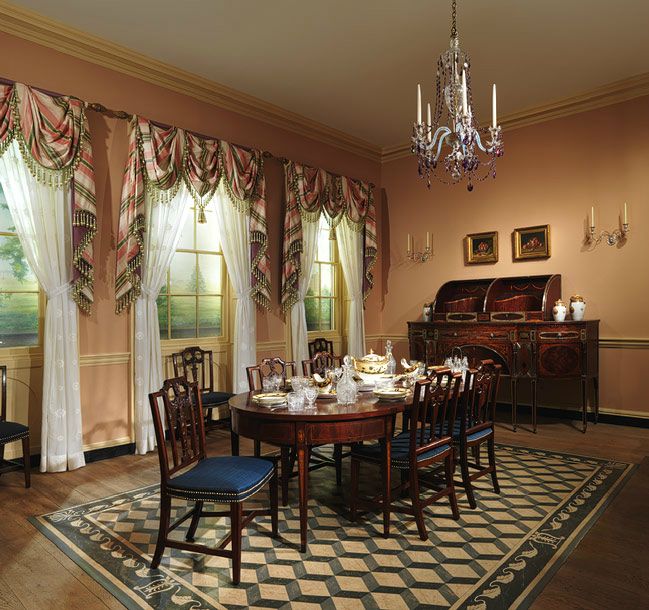
Drop-leaf dining tables, 1795 - 1810
Baltimore
Mahogany, holly with yellow poplar, white pine, sycamore;
28 3/4 x 47 7/8 x 78 1/2 in.
The Metropolitan Museum of Art

Drop-leaf dining table (from above)
Detail of leg showing the graduated bell flowers
and the American Eagle

Drawing room of the Craig House, Baltimore, Maryland, ca. 1810
Metropolitan Museum of Art, New York City
Notes from the online exhibit:
The architectural elements of the Baltimore Room are from the parlor of a brick row house built for Henry Craig between 1810 and 1811. The parlor was the most important room in Henry Craig's dwelling devoted to entertaining guests. Accordingly, it contained the finest woodwork, which illustrates a delicacy and restraint typical of the Neoclassical style of the period.-------------------------------------------------------------------------------------------------------------------------------------------------------------
I usually sit pen in hand while watching PBS' Antiques Roadshow. It is one of the few programs (or places) where old and hidden treasures get revealed.
This past week, the show was from Detroit. We forget that before Detroit deteriorated, it was a wealthy city.
One lovely piece of furniture that showed up at the auction was a Baltimore Federal Era Center Table.

Baltimore Federal Era Center Table
Mahogany
ca. 1790
From the Antiques Road Show, Detroit
Which aired in February 3, 2014

Baltimore Federal Era Center Table
Detail of leg, showing graduated bell flowers
The appraiser says about the table:
They made these Baltimore style tables in the 1880s, 1890s, 1900, 1910. And so they were copies of the original tables.This is what I could find out about this style:
...The good news is that you have a really fully inlaid table. A really high styled table...We're going to try and figure out now whether its First Period or Second Period...You have period table from 1785 to 1795, maybe 1800, so it's a real thing.
...The legs have graduated bell flowers, which are sand-burnt to make them three dimensional....
In the years immediately following the Revolution, Baltimore became an important port, and a school of cabinetmaking flourished there during the Federal period [1780-1820]. Elaborate pieces of painted furniture made the Baltimore pieces’ sophistication and grace hard to match. In addition to the painted furniture, Baltimore was known for its use of églomisé (glass panels with symbolic figures) and large ovals inlaid in mitered panels. Like Baltimore, Annapolis also became an important Maryland cabinetmaking center. The most prominent craftsman was John Shaw. A labeled mahogany bookcase-desk by John Shaw was made in 1797 and formerly stood in the Kennedy Green Room in the White House. It is now is shown in the Diplomatic Reception Room. The Maryland State House holds a desk for the President of the Senate made by John Shaw in the same year. [Source: Bartley Classic Reproductions]And:
Baltimore furniture, decorated with paint or fancy wood inlays, and beautifully detalied Baltimore silver of this period [the Federal era] took their places in the forefront of American design. The merchants=craftsmen John and Hugh Finlay typified the trade; they advertized in 1803 that they had for sale but would "also make to any pattern all kinds of fancy and Japanned furniture." Their wares and shop skills ran to car, pier, tea, dressing, writing and shaving tables; stands for candles and washpans; bedsteads along with bed and window cornices; cane-seat, rush-seats and Windsor chairs; and fire and candle screens "with or without views adjacent to the city." In this flush time of European war and Baltimore profit, the wealthiest Baltimoreans could afford interiors, furnishings and finery that spoke clearly of personal and family taste. [Source: The Architecture of Baltimore: An Illustrated History. Mary Ellen Hayward and Frank R. Shivers, eds. John Hopkins University Press, 2004. P. 29. Full Text Online, here]General information from Wikipedia:
Federal furniture refers to American furniture produced in the Federal Period, which lasted from approximately 1789 to 1823. Notable furniture makers who worked in the federal style included Duncan Phyfe and Charles-Honoré Lannuier. It was influenced by the Georgian and Adam styles, and was superseded by the American Empire style...
Pieces in this style are characterized by their sharply geometric forms, legs that are usually straight rather than curved, contrasting veneers, and geometric inlay patterns on otherwise flat surfaces. Pictorial motifs, when extant, usually reference the new federal government with symbols such as the eagle. [Source: Wikipedia]

Contemporary version of a Federal Style side board
At Bartley Classic Reproduction
The full Antiques Roadshow video is here. The section on the center table appraisal starts around the 8 min. point.
-------------------------------------------------------------------------------------------------------------------------------------------------------------
Posted By: Kidist P. Asrat
-------------------------------------------------------------------------------------------------------------------------------------------------------------
